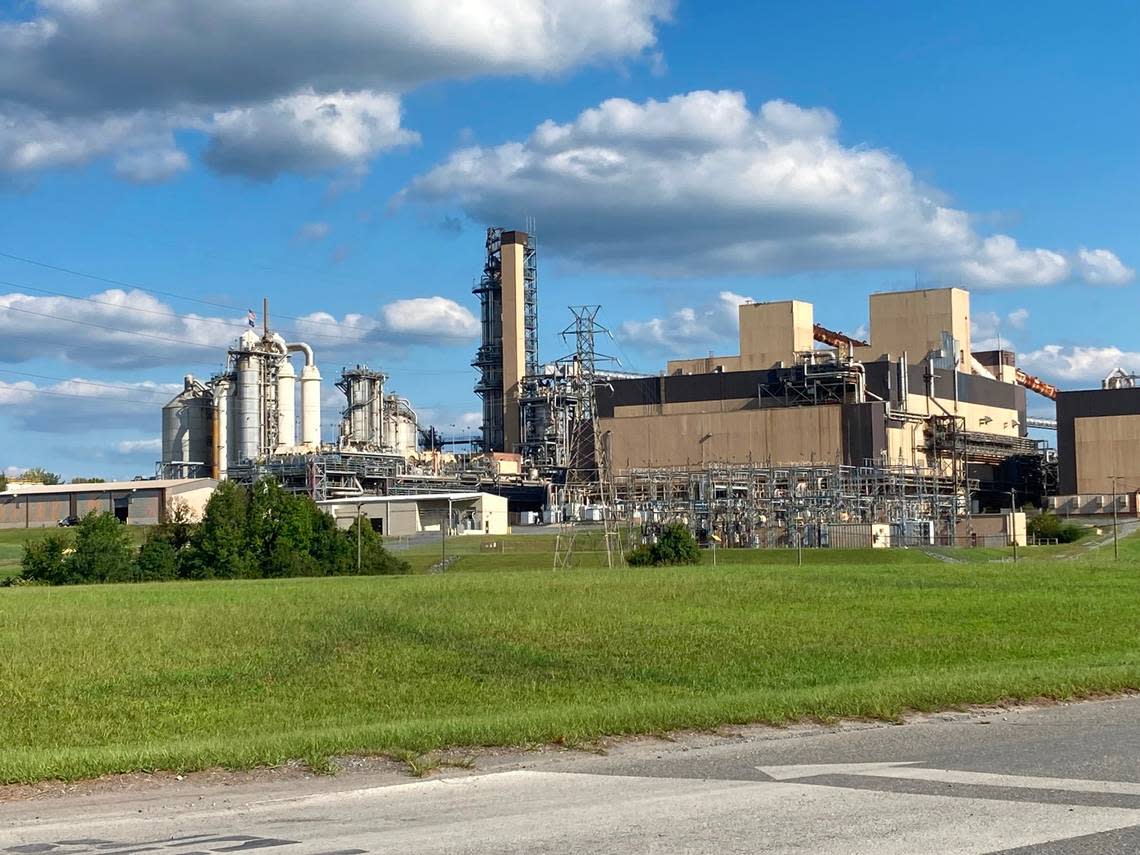SC paper mill disputes report that toxins have drained from its property to river
When a team of attorneys contacted the New-Indy paper company earlier this month, they explained that dioxin, a highly toxic chemical linked to an array of illnesses, was draining from the company’s York County mill to the Catawba River.
It was a chilling report, showing that up to 100 million gallons of groundwater polluted with dioxin and other chemicals were seeping to the Catawba each year from the more than 60-year-old paper mill south of Charlotte.
Now, after initially declining to comment publicly about the report, New-Indy has plenty to say.
In a sharply worded response to questions from The State Media Co., the paper company blasted the attorneys’ conclusions, saying that hazardous levels of dioxin have not been found in the property’s groundwater monitoring wells, much less in the Catawba River.
The company, owned in part by New England Patriots owner Robert Kraft, said the letter from the attorneys group is a ploy by the lawyers to help legal cases against New-Indy.
Those attorneys, from some of the most prominent law firms in two states, already have sued the company over powerful odors that produced nearly 50,000 citizen complaints. The lawyers now are threatening to take more legal action against New-Indy over alleged water pollution and hazardous waste violations.
The statement emailed by New-Indy to The State on Wednesday night called the lawyers’ findings “baseless accusations.’’ The company concedes dioxin has been discovered on the property, but says New-Indy has spent considerable time keeping an eye on the pollution, which it says is within acceptable government standards.
“No hazardous level of dioxin was detected in any’’ monitoring wells tested recently by company-hired consultants, New-Indy said.
The highest level of dioxin New-Indy says it has found is only one-fifteenth of the amount South Carolina permits in drinking water.
“Dioxins occur in many areas,’’ a later company statement said. “For instance, grilling meats generates dioxins. The government establishes the maximum allowable concentration of these materials. And levels detected below government-established thresholds are deemed acceptable.’’
The company also said dioxin found at the site was not produced by New-Indy’s operations. The company acquired the plant four years ago. Dioxin is an industrial byproduct produced by many paper mills years ago.
“Dioxin is a highly toxic chemical. Small amounts of the compound were left on the property by a previous owner of the facility, a byproduct of the bleaching process,’’ the company said., noting that the practice was discontinued nearly two decades ago. “At no point since New-Indy acquired the mill on Dec. 31, 2018, has the facility produced dioxin..’’
Environmental cleanup requirements generally apply to the owner of contaminated property, even if the current owner did not cause the pollution.
New Indy had declined to comment Tuesday on questions about dioxin draining to the river, but after The State reported on the issue Wednesday morning, a company spokesman sent out a statement Wednesday night.

Bitter fight
New-Indy’s contention that dioxin is not hurting the river is the latest development in what has become one of South Carolina’s biggest environmental stories, a bitter fight between the company and its neighbors over how plant operations have affected the surrounding area.
Since the company switched manufacturing processes at the plant in 2021, it has drawn severe criticism from people who say the change produced odors so powerful many became nauseated, developed headaches and could not spend prolonged periods outside their homes.
State and federal regulators have fined the company more than $1 million, and residents have filed lawsuits over the stench they say has come from the paper mill near the Catawba River.
The most recent donnybrook is over water pollution and hazardous waste at New-Indy that some residents say threaten the Catawba, a broad river that supplies drinking water and provides recreation for thousands of people.
Dioxin, an industrial byproduct with many different types, is among multiple pollutants that consultants say have drained off the site to the river. But dioxin is a particular concern because some forms of it are considered among the world’s most dangerous chemicals.
One of those — 2,3,7,8 TCDD — can cause cancer and other health ailments, including severe skin problems and liver damage. It has been found in groundwater at the site and in sludge in a series of waste ponds near the river, according to the S.C. Department of Health and Environmental Control.

Lawyers who raised the most recent alarms on behalf of the residents say New-Indy’s response was expected, but they aren’t backing down on conclusions made in their Oct. 20 letter to a top company official.
Research they referenced in the letter came from testing and a consulting report the team commissioned, the attorneys said.
““We have conclusive evidence to support the claims made on behalf of local citizens and stand by the data in our notice letter,’’ a spokeswoman for the legal group said in an email. “We look forward to the truth coming to light as we continue to work to end this dangerous pollution and hold New-Indy fully accountable.”
Regardless of whether the dioxin levels are within the federal safe drinking water limit, as New-Indy indicated, attorneys for the citizens say any level of dioxin in groundwater or the river is a concern. The U.S. Environmental Protection Agency has set a maximum contaminant level goal of zero for one form of dioxin found in groundwater and sludge at the New-Indy site.
Six law firms sent the letter to New-Indy, including Motley Rice of Charleston and Baird Mandalas Brockstedt Federico & Cardea of Delaware, both of which have extensive experience representing citizens against corporations. Others involved include the Harpootlian firm of Columbia, the Elrod Pope firm of Rock Hill, the Stavrinakis firm of Charleston and the Mauney firm of Charlotte, NC.
Trickling toxins
In their Oct. 20 letter to New-Indy, the attorneys said recent groundwater and soil tests show dioxin and other contaminants, including cobalt, are trickling to the river. Soil adjacent to seeping areas had dioxin, as did groundwater, according to the attorneys group, which says its testing is more extensive than New-Indy’s.
Their consultants took soil and groundwater tests from about a dozen spots along the river, according to a report the lawyers provided to The State. A report provided by New-Indy to The State showed only two spots along the river where groundwater testing is done.
The lawyers also hired S.S. Papadopulos & Associates, a national company that specializes in groundwater and hydrogeological consulting. Harvey Cohen, a hydrogeologist with the company, wrote a detailed assessment of threats from toxins on the site to the Catawba River.
“It is probable that contaminated groundwater and seep contamination has been and is being discharged to the Catawba River,’’ according to the Oct. 17 assessment Cohen provided Motley Rice attorney David Hoyle.
Relying on multiple reports, including the 2022 Cohen assessment, attorneys said in their Oct. 20 letter to New-Indy that up to 100 million gallons of groundwater containing dioxin and other pollutants are draining into the Catawba River every year.
“Upon information, belief and the expert report of Dr. Cohen, the leakage of process water and manufacturing byproducts from New-Indy’s lagoons and holding ponds has contributed to elevated levels of dioxin, cobalt and other constituents of concern in the groundwater that enters the Catawba River, as well as to the sediments in the Catawba River,’’ the Oct. 20 letter said.
The letter accused New-Indy of violating environmental laws, including the federal Clean Water Act, and threatened to sue the company again. The attorneys’ letter said there is “an imminent and substantial’’ danger to health and the environment from pollution at New-Indy.
Interestingly, some of the dioxin Cohen’s study identified along the river’s edge and in soil adjacent to the river is different from some of the form found in groundwater on the site and in the sludge lagoons near the river, records show.

Overall, the Cohen report documents a movement of groundwater toward the river, indicating that pollution in the groundwater is reaching the Catawba, the team of lawyers says.
Brandon Jones, the riverkeeper for the Catawba, said the groundwater movement is a concern, as is whether pollution could pour into the river if riverside waste ponds broke. The slow drip of contaminants seeping toward the river can’t be ignored, particularly because fish and other aquatic life could build up toxins over time, Jones said.
Jones said state regulators need to require New-Indy to clean out and close polluted waste ponds near the river.
“This is kind of a ticking time bomb that has been there for a very long time,’’ he said. “But we’ve seen evidence now that groundwater from the site that is contaminated is going into the river. We are asking DHEC to stop that.’’
So far, drinking water intakes nearby have not shown dioxin in the water, he said.
Other chemicals found
While New-Indy’s statement from late Wednesday included a monitoring study indicating dioxin did not exceed safe drinking water standards, the study said at least four other chemicals did exceed the drinking water limits.
Tests done by the S&ME consulting firm found chlorobenzene, 1-2 dichlorobenzene, 1-4 dichlorobenzene and 1-1 dichloroethene. All can cause health problems, depending on the exposure. Chlorobenzene and 1-1 dichloroethene, for instance, can cause liver and kidney damage and eye irritation.
New-Indy issued another statement Thursday saying the chemicals had been found in the interior of the property, well away from the Catawba River.
“New-Indy is sampling these wells annually and reporting results to DHEC,’’ the company said.
As the two sides go at each other, the S.C. Department of Health and Environmental Control says it is continuing to monitor the New-Indy site.
DHEC said it previously has had no evidence that dioxin is draining into the river, but DHEC also said it is assessing the legal team’s findings, outlined in the Oct. 20 letter to New Indy, on which the environmental agency was copied.
The department, criticized for allowing New-Indy to remove key pollution control equipment after acquiring the old Bowater factory about four years ago, has fined the company nearly $130,000. Its director said recently that New-Indy had misled the department while modernizing the plant, which is when it removed the pollution control equipment.
Former state Rep. Mandy Powers Norrell, D-Lancaster, said the New-Indy situation is troubling to her. She’s one of the six area residents represented by the lawyers who wrote the Oct. 20 letter to New-Indy about pollution draining from the site into the Catawba River
She said New-Indy’s response to the attorneys’ findings is not reassuring.
“I don’t generally take comfort in the argument there is not enough to kill you,’’ she said. “They are accepting the fact there is still dioxin there and expecting everybody to be OK with that.’’

